Physical Address
304 North Cardinal St.
Dorchester Center, MA 02124
The orbit is the bony cavity that contains the eye, eye muscles, lacrimal gland, and other structures that serve eye functions. Numerous diseases affect the orbit and can involve any of these tissues, including neural, muscular, vascular, lymphatic, and connective tissues. The pathology can sometimes be determined by a combination of clinical and imaging characteristics, but in many cases will require a biopsy for histopathological examination.
A mass lesion of the orbit may cause proptosis, displacement of the eye, and visual loss.
Orbital lesions may be the presenting sign of systemic diseases, such as metastatic cancer or immunological disorders.
Demographics such as age, sex, time course of presentation, and location within the orbit may be helpful in constructing an initial differential diagnosis.
Treatment of orbital lesions may be medical, such as the use of corticosteroids or radiotherapy for inflammatory disease, and does not always require surgery.
The orbit and ocular adnexa are important sites for primary and secondary diseases and can be a window into systemic disease. Various tissue types, such as osseous, vascular, neural, muscular, fibrous, adipose, and glandular, may be involved with specific pathologies. Tumors or inflammations can secondarily invade the orbit from periorbital regions, such as the paranasal sinuses, eyelids, and intracranial compartment. Knowledge of the most important presenting clinical characteristics can guide the physician in establishing a differential diagnosis that is critical in deciding on further radiological or laboratory studies. In many cases a biopsy and histopathology are necessary for definitive diagnosis.
The initial step in the evaluation of orbital disease is a complete ophthalmic examination. A careful medical and ophthalmic history, including time course of the disease, past trauma, ocular surgery, and systemic illnesses, must be obtained. A comprehensive clinical examination should include assessment of visual acuity and visual fields, anterior and posterior segment ocular evaluation, optic nerve function, and external and periorbital adnexal inspection. The use of modern imaging techniques is almost always indicated, and the choice depends on the disease processes suspected.
In this chapter, the most common orbital lesions are categorized by diagnostic criteria to enable the reader to evaluate patients more easily and establish a meaningful differential diagnosis ( Tables 12.10.1–12.10.3 ). In addition, the key points and diagnostic criteria for each lesion are given.
| Diagnostic Group | Frequency (%) |
|---|---|
| Thyroid orbitopathy | 50 |
| Inflammatory lesions | 11 |
| Cystic lesions | 10 |
| Lymphoproliferative lesions | 5 |
| Other and unclassified | 5 |
| Vascular neoplasms | 4 |
| Secondary tumors | 4 |
| Mesenchymal lesions | 4 |
| Optic nerve tumors | 3 |
| Lacrimal gland lesions | 2 |
| Metastatic tumors | 2 |
| Vascular, structural | 1 |
| Diagnostic Group | Frequency (%) | ||
|---|---|---|---|
| Childhood and Adolescence (0–20 years) | Middle Age (21–60 years) | Later Adult Life (61+ years) | |
| Adenoid cystic carcinoma of lacrimal gland | 18 | 73 | 9 |
| Capillary hemangioma | 100 | 0 | 0 |
| Cavernous hemangioma | 10 | 75 | 15 |
| Cystic lesions | 77 | 3 | 4 |
| Fibrous histiocytoma | 25 | 50 | 25 |
| Infectious processes | 35 | 3 | 3 |
| Inflammatory lesions | 12 | 5 | 9 |
| Lymphangiomas | 6 | 1 | 0 |
| Lymphoproliferative diseases | 1 | 3 | 12 |
| Optic nerve glioma | 5 | 1 | 1 |
| Optic nerve meningioma | 4 | 88 | 8 |
| Pleomorphic adenoma of lacrimal gland | 0 | 89 | 11 |
| Rhabdomyosarcoma | 98 | 2 | 0 |
| Secondary and metastatic malignancies | 1 | 2 | 9 |
| Thyroid orbitopathy | 4 | 59 | 40 |
| Trauma | 7 | 4 | 2 |
| Hours | Days | Weeks | Months | Years |
|---|---|---|---|---|
| Traumatic | Inflammatory | Inflammatory | Neoplastic | Neoplastic |
| Hemorrhagic | Infectious | Neoplastic | Lymphoid | Degenerative |
| Infectious | Traumatic | Traumatic | Vascular | Lymphoid |
| Hemorrhagic | Lymphoid | Inflammatory | Vascular | |
| Vascular | Vascular | Degenerative | Inflammatory |
Metastatic tumors represent 2%–3% of all orbital tumors. In 30%–60% of patients, orbital metastases develop before the diagnosis of the primary tumor ( Table 12.10.4 ). Metastases reach the orbit via hematogenous spread and occur less commonly than do uveal metastases. In adults, metastases are usually carcinomas. In children, metastases are more likely to be sarcomas and embryonal tumors of neural origin. Only 4% of orbital metastases are bilateral. Clinical symptoms include proptosis, abaxial displacement of the globe, ptosis, diplopia, pain, and chemosis ( Fig. 12.10.1 ).
| Origin | Percent |
|---|---|
| Breast | 53 |
| Prostate | 11 |
| Gastrointestinal | 11 |
| Lung | 4 |
| Sarcomas and other | 21 |
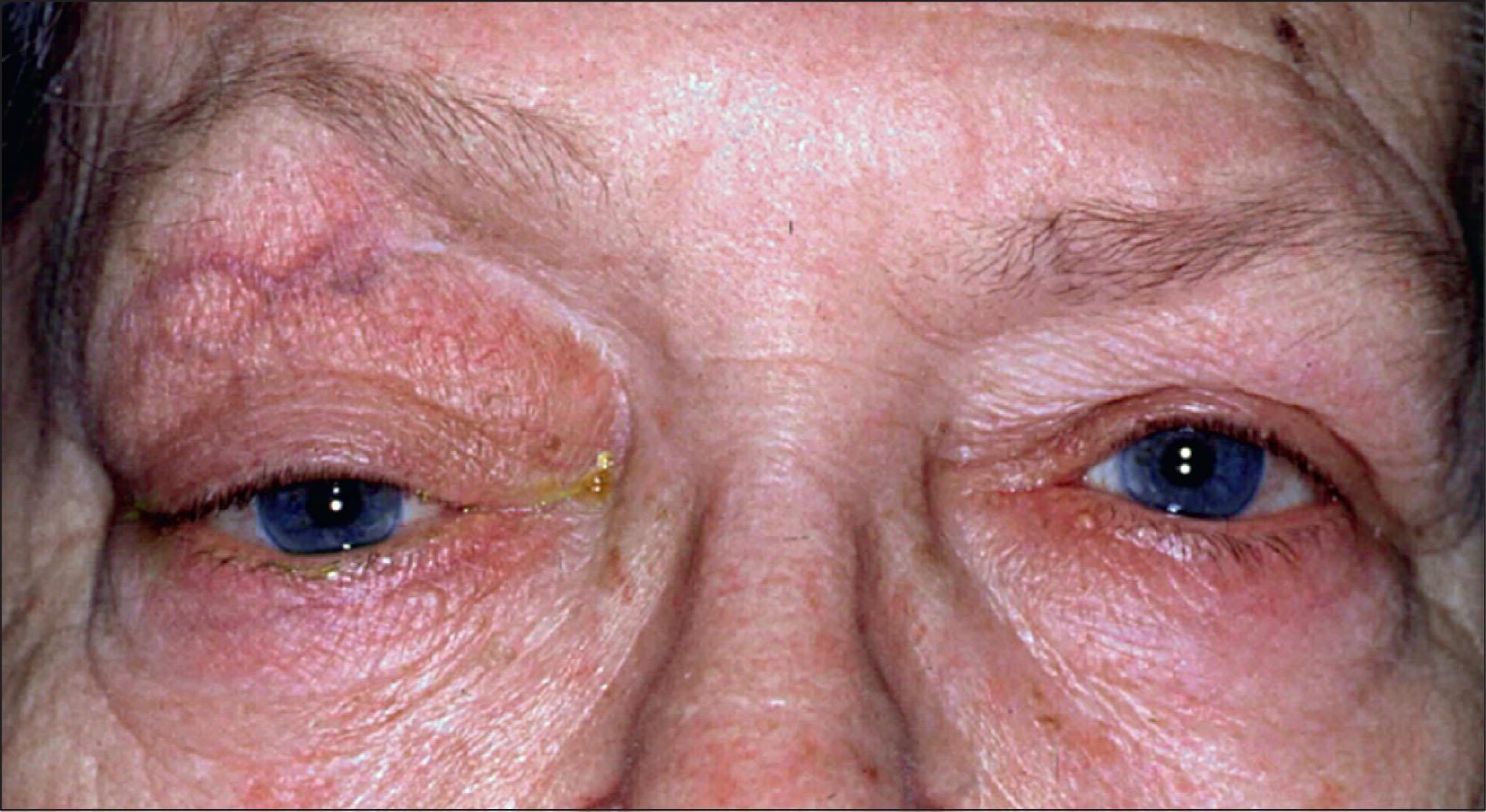
The most common primary sites of metastatic carcinoma to the orbit are the breast, lung, prostate, gastrointestinal tract, and kidney. Key features are:
For breast carcinoma, the interval from primary diagnosis to orbital metastasis is 3–5 years.
In scirrhous cell breast carcinoma and gastric carcinoma, enophthalmos may result from orbital fibrosis.
Metastatic lung cancer is seen most commonly in males aged 45–60 years who smoke and may present before the primary is discovered.
Prostatic metastases occur most commonly in elderly men, and pain is common because of bony involvement.
Metastases are characterized by a rapid onset of orbital symptoms, which include exophthalmos and globe displacement.
Metastatic carcinomas usually are poorly defined, nonencapsulated, diffuse masses that are somewhat infiltrative ( Fig. 12.10.2 ). Extraocular muscles are often involved. Osteoblastic changes may be seen with prostatic carcinoma. On magnetic resonance imaging (MRI), the T1-weighted image is usually isointense and the T2-weighted image hyperintense to muscle.
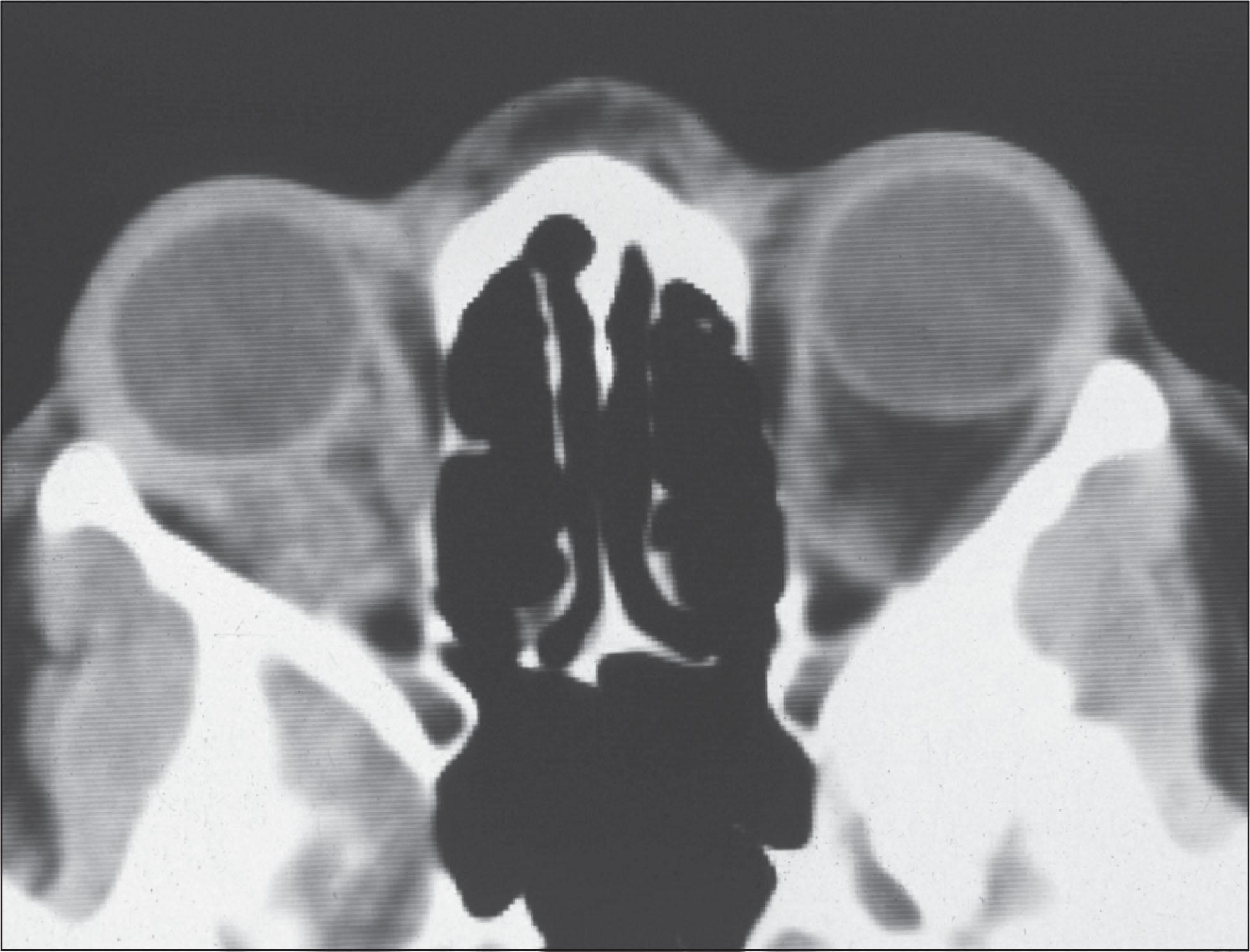
Treatment requires chemotherapy combined with local radiotherapy. Orchiectomy may be indicated for prostate carcinoma and hormonal therapy for breast carcinoma.
Orbital metastases from carcinoma often reflect more widespread systemic disease, so the prognosis for survival is generally poor.
Lesions of the lacrimal gland include infiltrative processes, such as inflammatory diseases and lymphoma, structural disorders (such as cysts), and epithelial neoplasms. Epithelial tumors represent 20%–25% of all lacrimal gland lesions. The appropriate management of lacrimal fossa lesions requires a thorough evaluation and determination of the cause. Almost all lacrimal gland lesions result in a mass effect, with swelling of the lateral eyelid and often with a downward and medial displacement of the globe ( Box 12.10.1 ). Inflammatory processes are more commonly associated with pain, eyelid edema, and conjunctival chemosis and injection.
Fibrous dysplasia
Frontal mucocele
Lymphoma
Neuroblastoma
Neurofibroma
Schwannoma
Subperiosteal hematoma
Thyroid orbitopathy
Lacrimal sac tumors
Lymphoma
Maxillary sinus tumor
Metastatic tumors
Ethmoid mucocele
Lacrimal sac tumors
Lethal midline granuloma
Metastatic tumors
Nasopharyngeal tumors
Rhabdomyosarcoma
Lacrimal fossa tumors
Sphenoid wing meningioma
Pleomorphic adenomas occur mainly in the orbital lobe and rarely in the palpebral lobe of the lacrimal gland. They are composed of epithelial and mesenchymal elements (thus the term benign “mixed” cell tumor), but both elements are derived from the epithelium. Key features are:
They represent 3%–5% of all orbital tumors, 25% of lacrimal mass lesions, and 50% of epithelial lacrimal gland tumors.
They occur most commonly in the second to fifth decades of life (mean age, 39 years).
The male to female ratio is 1.5:1.
Orbital symptoms are painless proptosis, downward and medial displacement of the globe, diplopia, retinal striae, fullness of the upper eyelid, and a palpable eyelid mass. These tumors are slowly progressive, usually over 12 or more months.
Well-circumscribed, round-to-oval, encapsulated lesions are typical. Remolding of the bone may be seen with long-standing tumors, but no bone destruction occurs. The tumors may be cystic and may contain areas of calcification. On MRI the T1-weighted image is hypointense and the T2-weighted image hyperintense to muscle.
Pleomorphic adenomas are encapsulated tumors that demonstrate ducts, cords, and squamous pearls, with myxoid and chondroid tissue ( Fig. 12.10.3 ).
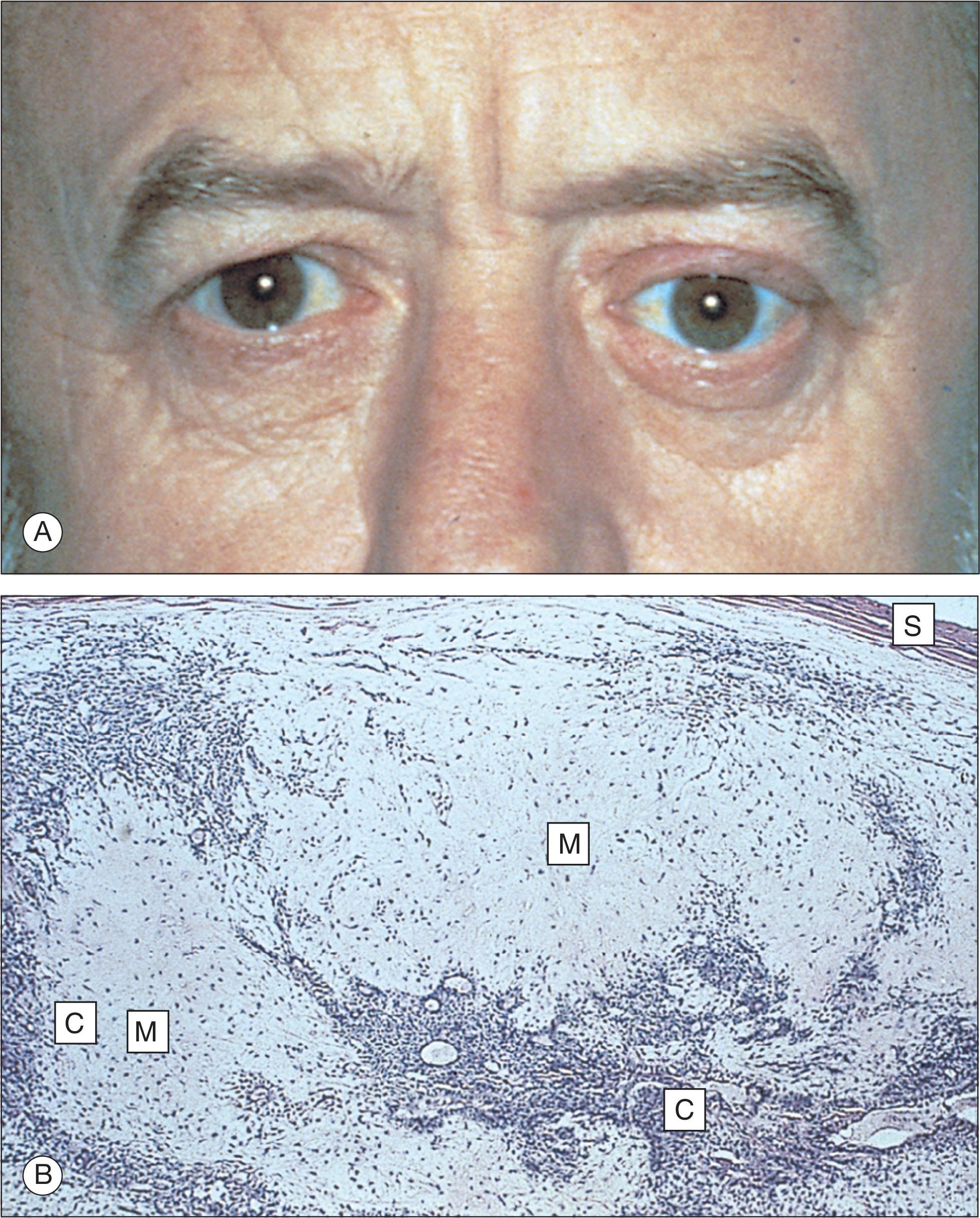
These adenomas must be excised completely with an intact capsule; biopsy or incomplete removal may result in recurrence associated with infiltration. Malignant degeneration occurs at a rate of 10% in 10 years.
The prognosis generally is very good despite the small possibility of malignant transformation.
Adenoid cystic carcinoma accounts for 23% of all epithelial tumors of the lacrimal gland and is the most common epithelial malignancy of the lacrimal gland ( Table 12.10.5 ). Key features are:
It occurs most commonly in the fourth decade of life but may be seen at any age.
It is slightly more common in women.
The duration of symptoms is generally short—often less than 6 months and usually less than 12 months.
| Lesion | Frequency (%) |
|---|---|
| Dacryoadenitis | 51 |
| Pleomorphic adenoma | 18 |
| Reactive lymphoid hyperplasia | 9 |
| Adenoid cystic carcinoma | 7 |
| Dacryops (epithelial cyst) | 5 |
| Lymphoma | 4 |
| Mucoepidermoid carcinoma | 3 |
| Pleomorphic adenocarcinoma | 2 |
| Plasmacytoid lesions | 1 |
Orbital symptoms include proptosis, downward globe displacement, ptosis, and diplopia. Orbital pain as a result of peri-neural spread is common, seen in 10%–40% of cases.
Computed tomography (CT) and MRI usually show a poorly demarcated, irregular lesion that may extend along the lateral wall to the orbital apex. Bone destruction is common, and foci of calcification are seen frequently. On MRI the T1- and T2-weighted images are hyperintense to muscle, and the signal is heterogeneous.
Solid cords of malignant epithelial cells are seen, with cystic spaces (“Swiss cheese” appearance) or hyalinization of cylinders of connective tissue ( Fig. 12.10.4 ).
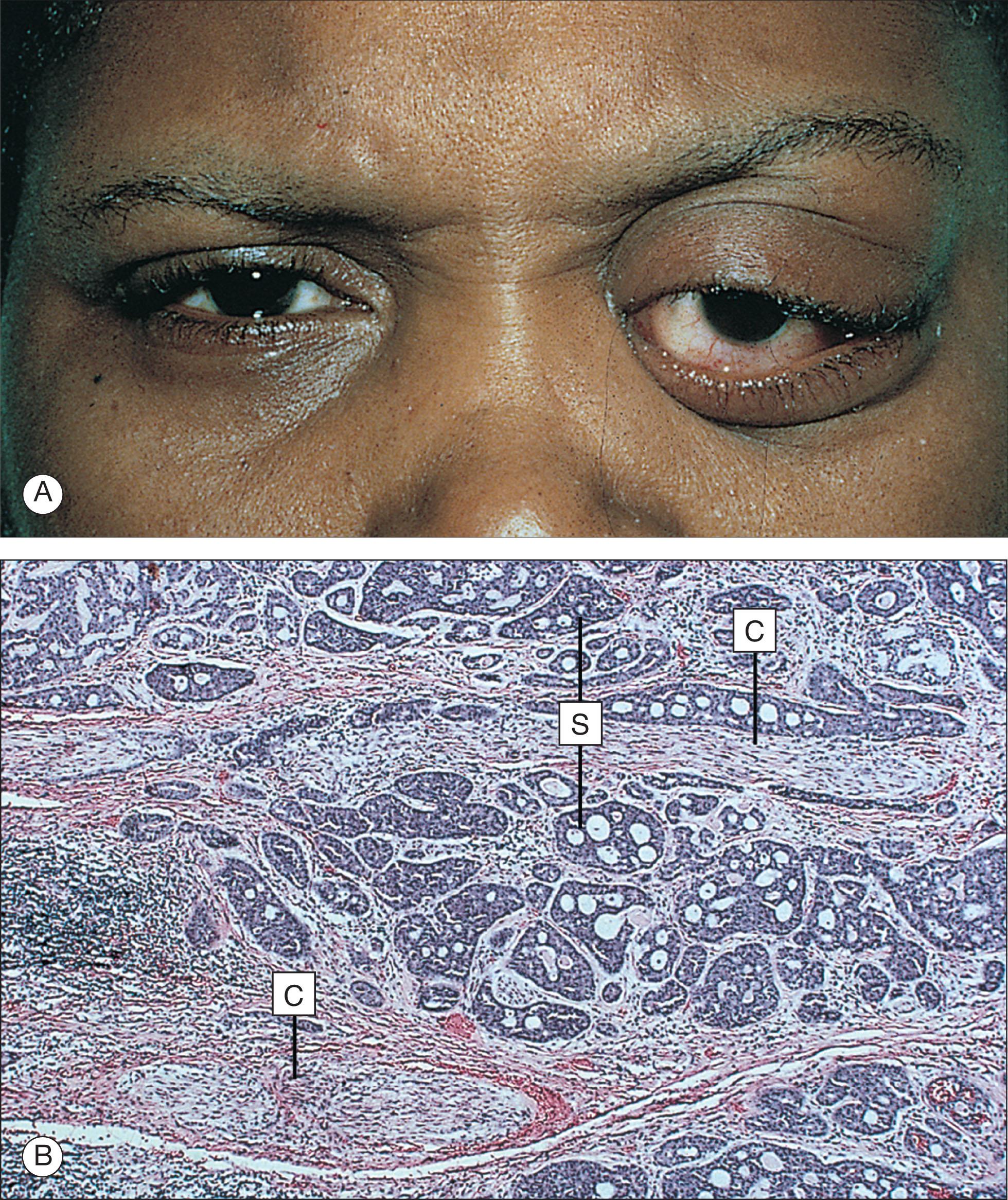
Treatment consists of radical en bloc excision or exenteration, with wide margins including bone. A recent histological study showed that 80% of these lesions involved microinvasion of adjacent bone. Adjunctive radiotherapy for incompletely excised lesions may be necessary. The prognosis is often poor, with relentless recurrences. The mortality rate is high.
Nonosseous mesenchymal tumors arise from fibroblasts, myoblasts, and lipoblasts. Classification of such lesions is difficult, as their features overlap, so the terminology is confusing. Together these orbital lesions form an important group that accounts for about 8% of all orbital lesions.
Fibrous histiocytoma is a benign or malignant mesenchymal tumor that arises from fascia, muscle, or other soft tissues. In children, it may result from early orbital radiotherapy. In adults, it is the most common mesenchymal orbital tumor, usually seen in middle-aged patients (40–60 years).
The upper nasal quadrant is the most common orbital site. Symptoms are proptosis, decreased vision, ptosis, motility restriction, and epiphora. The lesions may be circumscribed or infiltrative and can be locally aggressive.
Usually a well-defined, rounded mass is seen, as in other benign lesions, but the tumor can be more infiltrative. On MRI the signal is heterogeneous, with isointense T1 and variable T2 signals with respect to muscle. Enhancement with gadolinium is moderate.
The tumor is a mixture of spindle-shaped fibroblasts and histiocytes arranged in a storiform pattern twisted about a central focus ( Fig. 12.10.5 ). The benign form (63% incidence) is a well-circumscribed, slow-growing lesion with a fine capsule. A small potential exists for malignant degeneration.
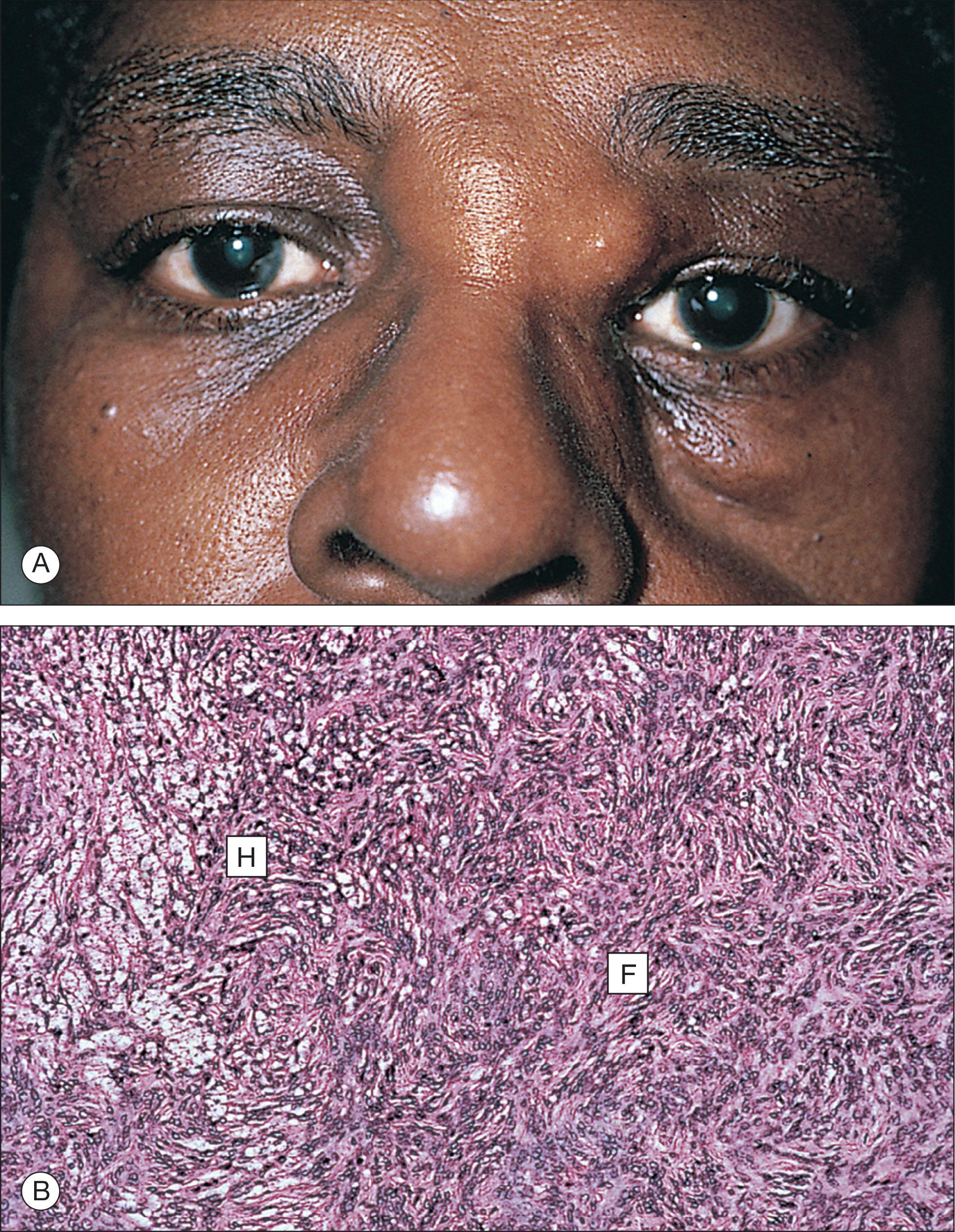
The malignant form (undifferentiated pleomorphic sarcoma) (37% incidence) is more infiltrative and rapidly growing and is often associated with pain and necrosis.
Local surgical excision for benign or orbital exenteration for malignant lesions is required, with recurrences being common (in up to 30% of cases). Radiotherapy offers no benefit, and the effects of chemotherapy are unknown.
For the benign form, the prognosis for life is excellent. With malignant tumors, the overall mortality rate is more than 40%.
Rhabdomyosarcoma is the most common soft tissue mesenchymal tumor in children, accounting for 3.4% of all childhood malignancies. The tumors arise from pluripotential mesenchymal precursors that normally differentiate into striated muscle cells. About 70% occur during the first decade of life (mean age, 7–8 years; range, 0–78 years), and boys are affected more commonly than girls at a ratio of 5:3. In the orbit the most common histological variant is the embryonal type, followed by the alveolar type.
Symptoms may be acute to subacute, with rapidly progressive proptosis, eyelid edema, and ptosis. This rapidity may cause diagnostic confusion with an infectious process. The tumor is located in the retrobulbar muscle cone in 50% of cases and in the superior orbit in 25% of cases.
Typically the tumor presents as an irregular but well-defined soft tissue mass ( Fig. 12.10.6 ). Bony erosion may be seen but is uncommon. On MRI the T1 signal is isointense to hyperintense, and the T2 signal is hyperintense with respect to muscle.
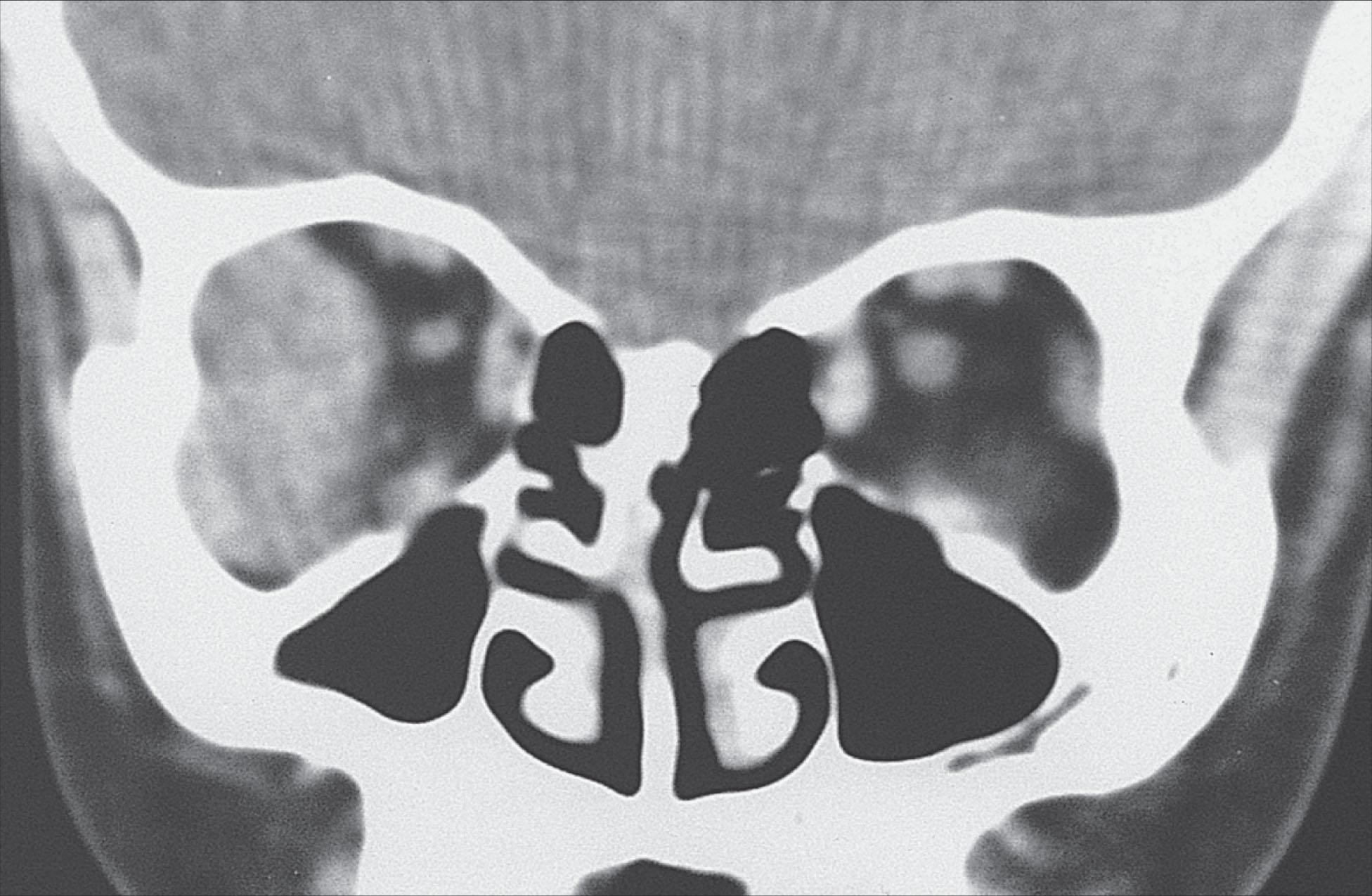
Cross-striations may be seen in 50%–60% of embryonal-type tumors and in 30% of the alveolar type ( Fig. 12.10.7 ). Myoglobulin is a specific immunohistochemical marker. Electron microscopy shows actin myofilaments and myosin filaments.
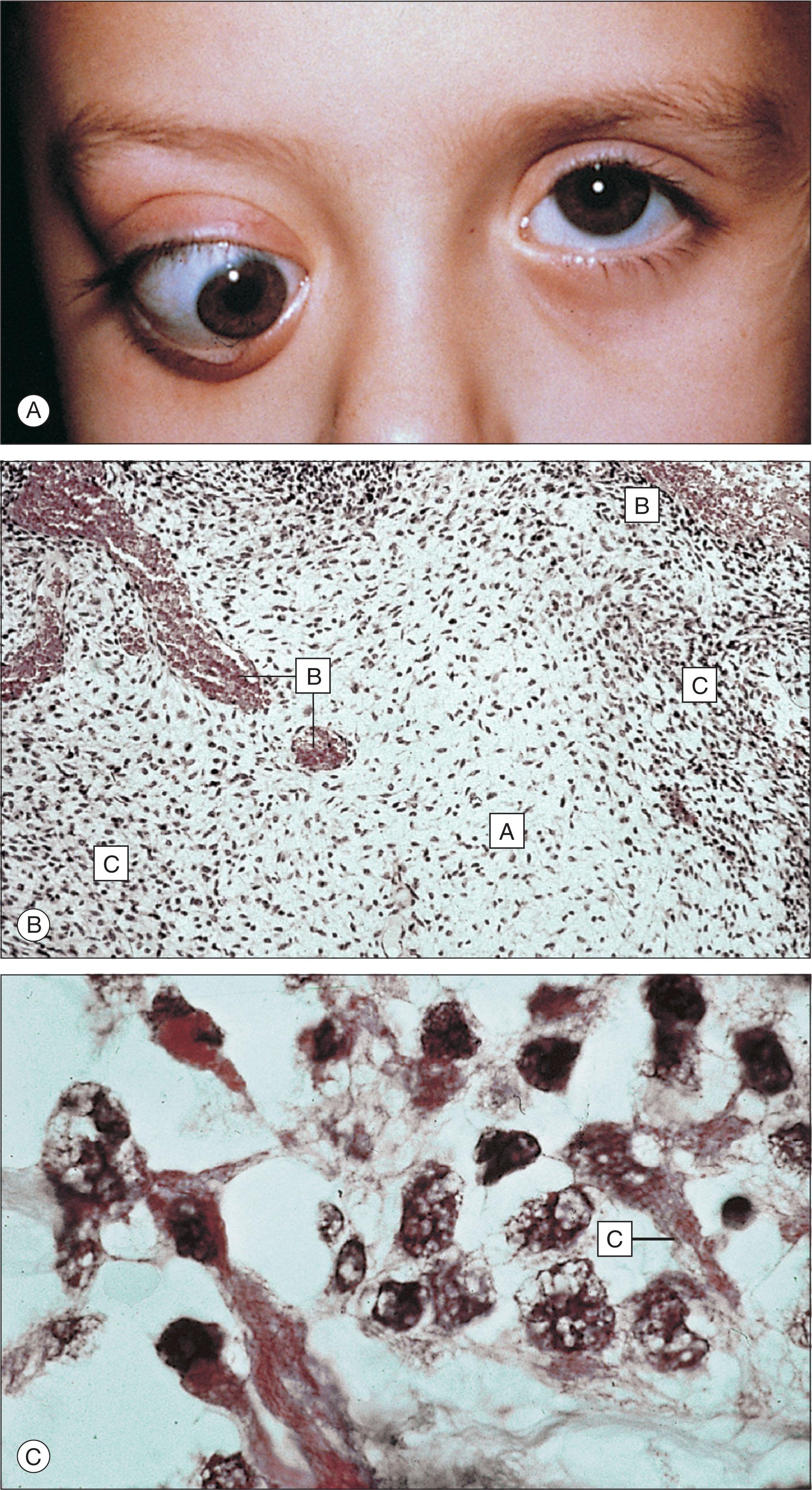
There are four stages of rhabdomyosarcoma:
Localized tumor, completely resected
Regional spread, ± positive nodes, grossly resected
Gross residual tumor remaining after incomplete resection
Distant metastases
In any child with rapidly progressive proptosis, imaging and an immediate biopsy are required to confirm the diagnosis. Surgical excision is carried out only if the lesion is well circumscribed and the excision can be performed easily without excessive tissue damage. Nonsurgical therapies have replaced previous radical orbital procedures. Local radiotherapy doses are 4000 cGy for stage II and 5000 cGy for stages III and IV. Adjuvant chemotherapy is given using vincristine, actinomycin D, and cyclophosphamide. Some centers prefer only surgery and chemotherapy to avoid the potential for radiation-induced orbital malignancies in younger children.
The 5-year survival rate is 90%–95%. A more favorable prognosis exists for orbital tumors because of the near absence of orbital lymphatics. For local treatment failures, orbital exenteration may be necessary.
Peripheral nerves in the orbit are subject to tumors that arise from various cellular components, such as Schwann cells, axons, endoneural fibroblasts, and nerve sheaths ( Table 12.10.6 ). In contrast, the optic nerve, which represents a white matter tract of the central nervous system (CNS), may give rise to CNS tumors such as astrocytomas and meningiomas.
| Lesion | Frequency (%) |
|---|---|
| Sphenoid wing meningioma | 30 |
| Optic nerve glioma | 22 |
| Neurofibroma | 19 |
| Schwannoma | 14 |
| Optic sheath meningioma | 11 |
| Other | 4 |
Plexiform neurofibroma is the most common benign peripheral nerve tumor in the eyelid and orbit and is considered characteristic of neurofibromatosis. The tumor grows along the nerve, is invasive, and is not encapsulated. Key features are:
A propensity for sensory nerves in the superior orbit, but may also involve motor, parasympathetic, and sympathetic nerves
Children in the first decade of life are affected most commonly
31% of plexiform neurofibromas occur in the eyelids
Clinically, this tumor has been described as a palpable “bag of worms,” with thickened overlying skin and an S-shaped eyelid ( Fig. 12.10.8 ).
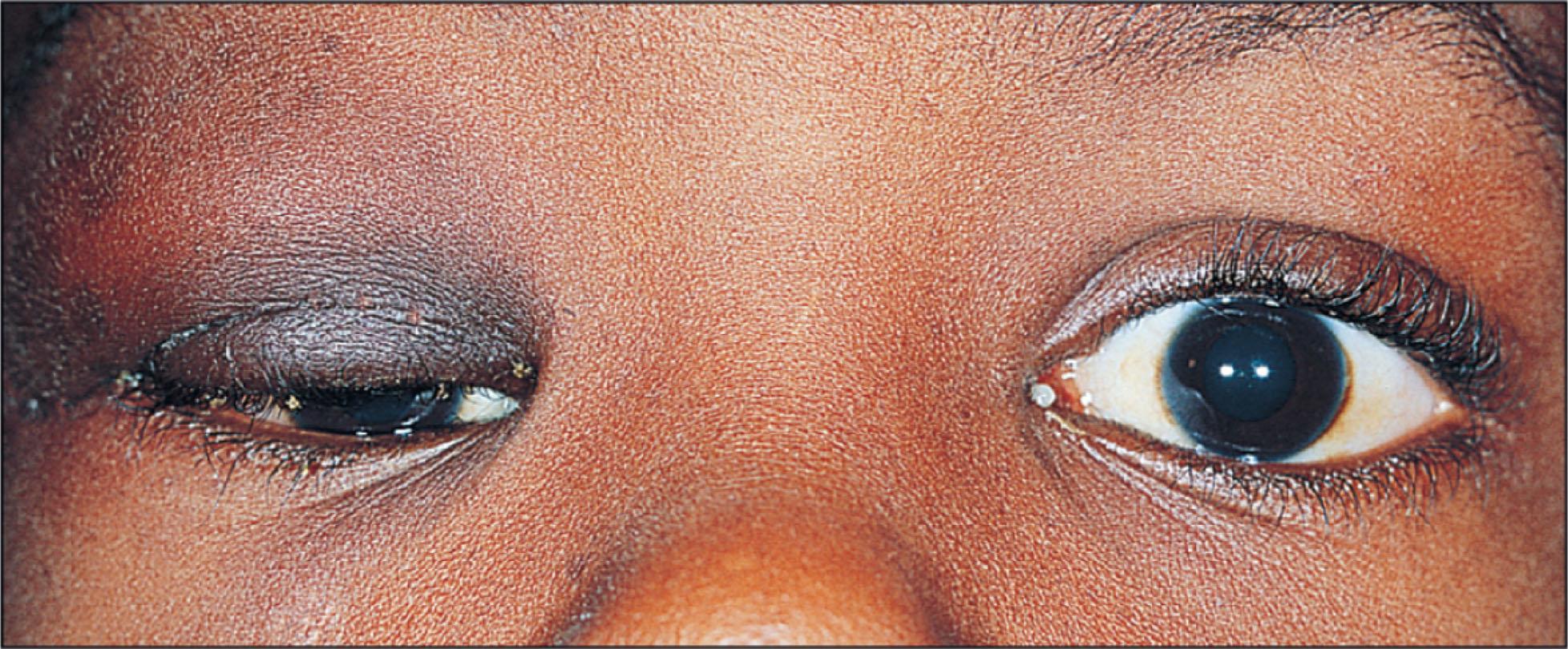
It may be associated with uveal neurofibromas (50%), iris (Lisch) nodules (77%), prominent corneal nerves (25%), optic nerve gliomas (15%), and pulsatile proptosis from an absence of the greater sphenoid wing.
A diffuse, irregular mass is seen with variable contrast enhancement. It may involve extraocular muscles, orbital fat, and the cavernous sinus. On MRI the T1 is hypointense and the T2 hyperintense to muscle.
Interwoven bundles of axons, Schwann cells, and endoneural fibroblasts are seen in a mucoid matrix ( Fig. 12.10.9 ). A characteristic cellular peri-neural sheath defines the tumor cords. Immunohistochemistry is positive for S100.
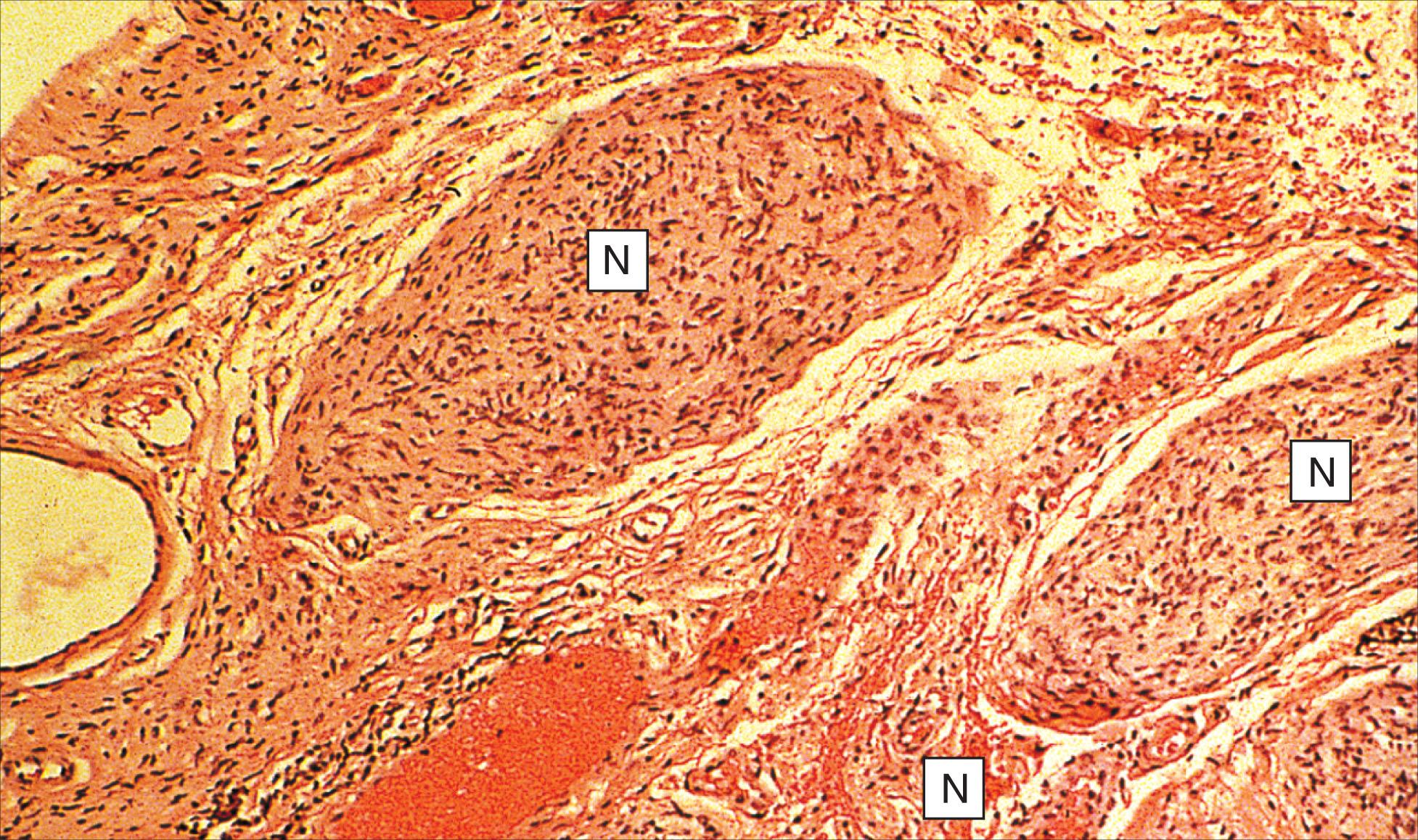
Surgical excision is almost always difficult and frustrating, with incomplete resection, excessive bleeding, and a poor cosmetic result. Repeated debulking may be necessary for severe symptoms and orbital exenteration for extensive cases. Radiotherapy offers no benefit.
There is a small risk of malignant transformation. These tumors may occasionally erode into the anterior cranial fossa, usually resulting in death.
Schwannoma is a Schwann cell tumor of neural crest origin that arises as an outpouching from peripheral or cranial nerves (e.g., acoustic neuroma). Schwannomas represent 1% of all orbital tumors and 35% of peripheral nerve tumors. They are mostly benign but rarely may undergo malignant transformation in patients with neurofibromatosis.
Schwannoma is seen most commonly in young adults to middle-aged individuals (20–50 years). It presents as a slow-growing, painless, well-defined solitary mass, usually in the superior orbit, and is frequently cystic. Orbital symptoms may include exophthalmos, diplopia, and visual loss from optic nerve compression.
The tumor is typically an extraconal, fusiform, well-defined, sometimes cystic mass that is aligned anteroposteriorly along the involved nerve. On MRI the signal is homogeneous to heterogeneous; T1 is hypointense and T2 isointense to muscle.
The encapsulated mass has yellow areas and patterns of cells described as Antoni A (whorls) or Antoni B (no palisading) patterns ( Fig. 12.10.10 ). Spindle cells are seen with vesiculated nuclei in a palisading configuration. The cells are negative for Alcian blue and positive for S100.
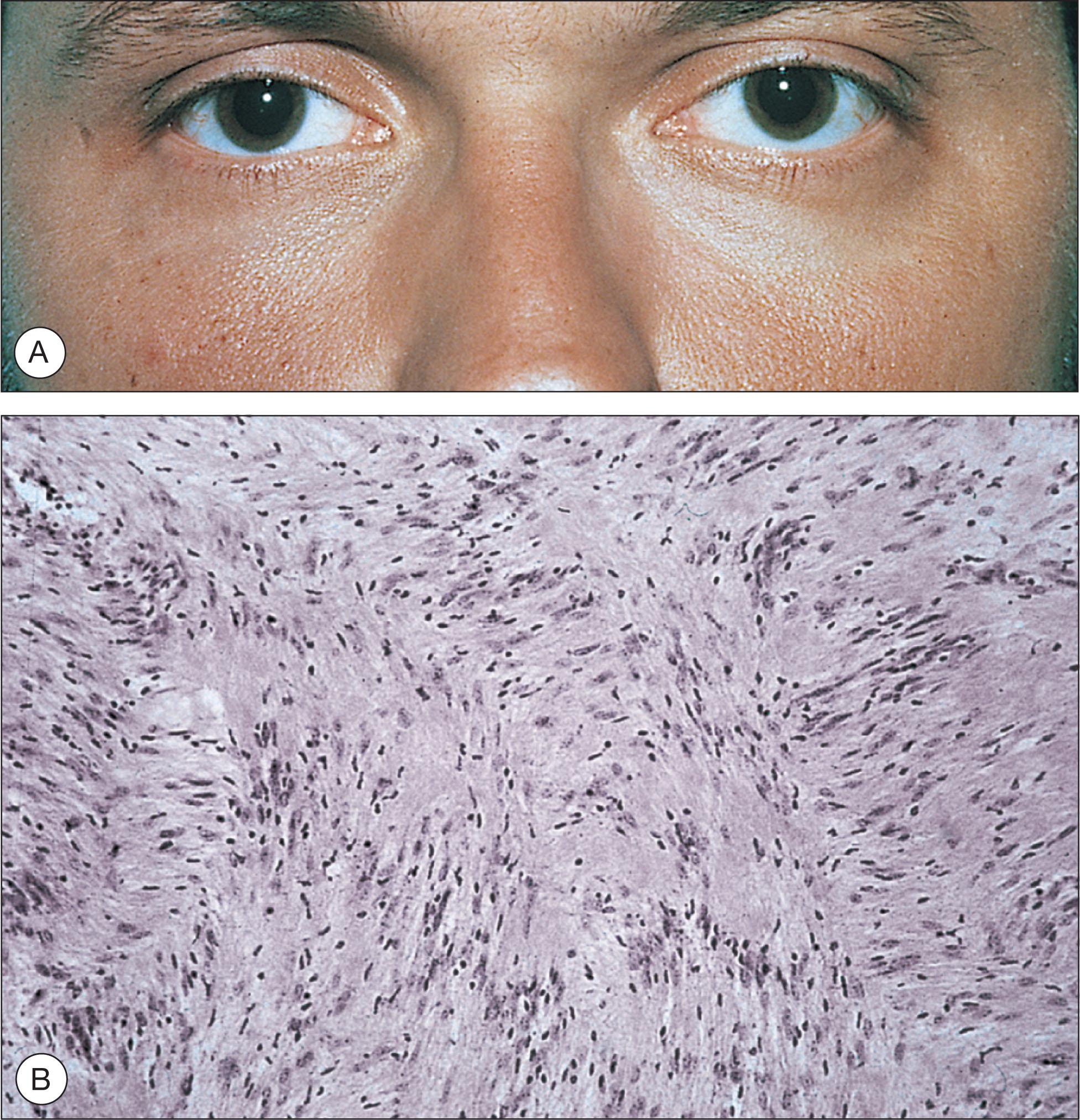
Surgical excision is the recommended treatment. The prognosis for life is good, except for those cases with intracranial spread. Late orbital recurrences may be seen after partial excision.
Malignant peripheral nerve sheath tumors are rare malignant tumors of Schwann cells and peri-neural cells that arise de novo or in association with neurofibromatosis. When associated with neurofibromatosis, the onset is slow and characterized by proptosis, globe displacement, and occasionally pain, ptosis, visual loss, diplopia, and chemosis. The tumors generally occur in patients 20–50 years of age or earlier in neurofibromatosis.
The clinical course is characterized by relentless invasion along tissue planes to the middle cranial fossa. Metastases to the lungs are common.
A poorly defined, irregular mass is seen. Bone destruction may occur when the lesion is large.
The tumor has plexiform, swollen nerve bundles and spindle-shaped cells in whorls of interlacing fascicles.
Wide surgical resection is required. Ancillary chemotherapy and radiotherapy may be palliative only. Prognosis is very poor, with death from metastases or intracranial spread the usual outcome.
Become a Clinical Tree membership for Full access and enjoy Unlimited articles
If you are a member. Log in here